Review Questions
1. What is U.H, L.H. and W.B.? Can you demonstrate them comfortably?
2. What is the proper way to play shoulder pizzicato?
3. From this point on I will assume you have learned all of your notes on the D and A string. If you haven’t, then you should probably go back and spend more time with the earlier lessons.
Tribal Lament
How did you do with Tribal Lament? Watch and compare your playing to mine.
Hello and welcome to Stringsavvy.com Violin Lesson #8! In lesson #7 we learned about playing using different parts of our bow while adding fingered notes back into the mix. Today we are going to learn how to count Eighth Notes!
If you remember from lesson two we began counting “1 & 2 & 3 & 4 &”
This allowed us to keep a steady beat, similar to hopping between jumps while skipping rope. This act of splitting up a beat is called subdivision.
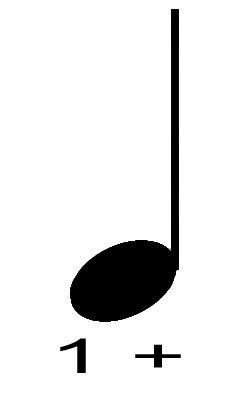
When we count Quarter Notes, each note begins on a number
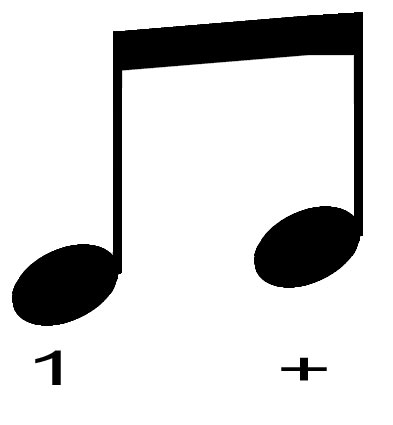
When we count Eighth Notes, each note begins both on both then number as well as the & (and). For each of these we refer to them as “The and of #.” For example if we wanted to refer to the “&” immediately after beat one, we would call it, “the & of 1.” Easy enough, right?
Now we combine the counting of Eight Notes and Quarter Notes! To make it easier, we are going to circle on the count whenever our bow moves.
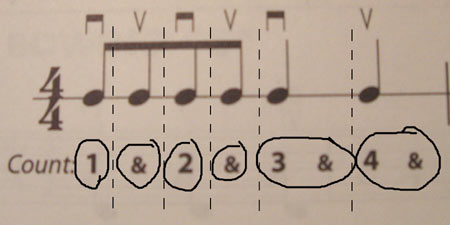
Make sure you don’t circle beat 4 of the 4th measure. Can you guess why?
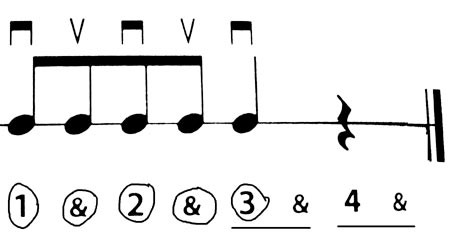
Adding Notes
You will notice that #67 is cleverly titled, “Pepperoni Pizza.” This is because it is an oral mnemonic that can help you understand the rhythm throughout this song. The notes are just a downward D Major scale
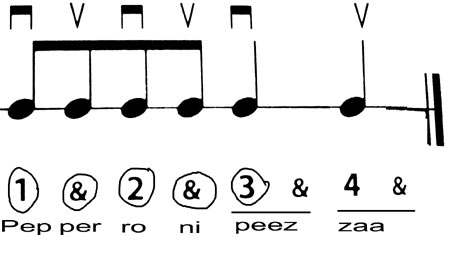
Rhythm Raps
Another way of counting is using what is called the Addition System. Instead of counting a Quarter Note as ONE AND, we count as WUH – UHN. This will help us associate in our head the idea of the length of a quarter note. The Eighth Note we will leave as is because those are to be played as two separate notes.
Use #68 for Example:
Wuh – uhn | 2 + | Three- ee | 4 +
Whenever you have a REST, just whisper the count for that beat.
Try this new counting with #70!
Turn the page and look at #82. You will notice that there is a “4+” written on TOP of the notes. This means to use your 4th finger (pinky) from your left hand to pluck the open string while the violin is on your shoulder. Be sure to keep a rounded finger while doing this.
If you don’t already have a metronome, now might be a good time to pick one up!
Review:
- Quarter Notes are played only during numbers ( 1 + 2 + 3 + 4 +)
- Can also be counted as Wuh-uhn Two-oo Three-ee Four-or
- Eighth Notes are played on both ONE and AND ( 1 + 2 + )
- You can combine these notes to make different rhythms
- Pepperoni Pizza (Also spoken as:)
- 1 + 2 + Three-ee Four-or
Vocabulary
Subdivide – splitting up a beat to better understand its length or count.
Assignment
- Count and Clap
- Quarter Notes
- Eighth Notes
- #66, 68, 72
- #67, 69, 70, 71, 73
- Be careful counting! Take a slow enough tempo so you can do this correctly!
- #82 – Left hand Pizzicato
- With your pinky (4th finger). Keep it rounded!
Back to Lesson Index
Back to Lesson 7
Foward to Lesson 9

 English
English
 French
French German
German Spanish
Spanish Russian
Russian
Sweetness. Nice to find sum fresh lessons online since im most likely never gonna pay for a teacher and ive seen and read everything else online. Dont Stop Making Lessons!!! ps. im intrested now in learning some bluegrass like music. Any links to free lessons on that? lol ive read everyting i can find for free but i still havent found what im looking for. maybe you’ll show me in one of your videos soon ^^
Hey Brandon! I’m glad you find the lessons helpful! I’m not sure where you could find links to bluegrass music, and I’m not too well versed in it myself. My background is much more classical and jazz.
However, I do strongly believe that in many of the folk styles (jazz, bluegrass, fiddle, etc) much of learning comes from immersing yourself in the music, trying to play along with recordings, and learning the style by ear. Have fun and keep making music! More lessons are on the way!
glad to have you back : )
Doubts:
1- we change the bow direction to get the 8notes,(up-down-up-dow) if we are playing the same note, but if the notes are D-E-F-G we just use a down bow for all?
2- Is there a rule to change the bow direction? or to make it long or half? For me, who played piano for years, the right hand wants to play the melody… and it changes direction according to notes,its hard. what does my right hand has to do? the bow only reads time? The can can song can you make a video of it? T_T
Hello Vanessa,
One of the cool things (and sometimes messes us up) is that the articulation can be marked by the fingers, bow, or both. In this case you should use a separate bow for each note.
There isn’t always concrete rule to the amount of bow to use per note, as it is determined by the length, volume, tempo, technique, articulation, etc. For faster notes you WILL tend use shorter bow strokes, simply to allow for time.
So yes, it can get confusing doing two different things, especially when you are used to a different instrument! For where we are now, the bow and the fingers will both move at the same time. This will change when we begin to add slurs.
My advice would be to get comfortable playing the Can Can in both the U.H and M.H. (The middle half exludes the bottom most quarter of the bow by the frog, and the top most by the tip.)
Sorry for the delay on Lesson 9- school has been crazy, new videos will be up soon!
thank you so much, delay gives time to pratice : ) and you are helping a lot
Hi my name is stephani and i got a bit of problem.. I have always wanted to learn how to play the violin since i was 8 years old.. never told anyone about it guess because it was i am deaf (moderate to severe hearing loss) was worried how the hearing people would think. Now im 26 years old and i know i can play the violin i dont worry about what people think…i have some hearing with the help of hearing aid i can differnate between the strings.. ***my question is have you ever heard or met a person that had hearing problems and was able to play the violin? (i know bethoven had lost his hearing but he used to hear growing up…i was born deaf never really heard real sounds I just want to be able to play a decent little music just for me… i bought a violin with no clue as to how to play haha but i am reading your lessons on lesson 3 now, and am planning on going to a music teacher i probably can only afford going twice a month… thanks stephani vidrine
Hello Stephani!
I do not know any violinists with hearing problems, but that could simply be because none of them had the determination to strive forward! I know a large part of violin playing comes from being able to hear pitches to set intonation, however, I’m sure with the help of your hearing aid and perhaps some bone conduction you will be able to pick up pitches. I have full confidence and believe anything is possible.
In Think and Grow Rich, Napoleon Hill writes that his son was born without ears. However, Hill encouraged his son and taught him that he could achieve anything. His child grew up to be top of his college class and end up very successful as a spokesman for some of the very first hearing aids.
I wish you the best of luck, and I hope you will keep me updated on your progress, as I’m sure other users on this site would be excited see you move along!
I have been meaning to write an article on a particular video by deaf percussionist Evelyn Glennie, but perhaps you could offer some of your own personal insight as you journey into music.
That link is the video plus a full transcript.
Hi Thom,
My name is Shang from Malaysia, and first of all thank you for creating these clips (lessons) as I am new to violin and I am glad to learn lots of things from your sites good job by the way.
The only thing which keep bothering me throughout the lessons is the tune of the violin, I am having a bad time tuning my violin as i am still not use to the way of proper tuning, as a result of that, I broke my strings 3 times in a month -.-| and still counting perhaps ….=_=|||. so i just have a small request from you Thom, that is it possible to have a *bonus* clips on tuning the violin in near future? thank you.
As for the other viewers, I would like to share these two links, as i think they are quite useful during practices. (Metronome/timer) and (Tuner for violin)
-Metronome – http://www.metronomeonline.com/
-Tuner- http://www.get-tuned.com/violin_tuner.php
enjoy and have a nice day V(^_^)V
Hello Shang,
I am so glad to hear from people all over the world!
Thank you for those links! I added them to the links on the right-hand navigation!
Yes, I will be making a bonus clip on tuning strings as well as putting strings on very soon, I just need to buy a new set of strings 😛
Hopefully after the video you won’t have any more broken strings!
Hi Shang from just across the causeway,
i’m in no way anywhere close to being an expert in tuning strings but i totally encountered the same problem when i first got my violin so thought i can maybe share a few things which solved the problem for me…
What i took a lot of time to get used to is that unlike a lot of other instruments (eg guitar) the tuner in the violin is not geared and all that’s holding the tight string is friction between the pegs and the wood on the violin. thus, the pegs slip very easily for beginners trying to tune it like us… out of frustration perhaps (speaking from personal experience haha), i’d just twist the peg even more and the strings snaps rather easily once a bit above the desired note
i found the trick is to slowly turn the pegs until it is roughly near the note u want (don’t bother getting it perfect). then push the peg slowly further into the hold it’s intended in and slowly release the grip. with a few tries and luck u might find that it will hold it’s position and not slip away… from then on it’s just a matter of using the fine tuners at the bottom of the violin (which is infinitely easier to use) to get it to the correct pitch
hope that helps
PS (to Thom… i’m still working on uploading a video of me playing but recently been a bit busy and when i finally get to play i’m struggling to get a decent clip haha. it’s so much different with the pressure of a camera staring in your face. i guess i know 10% of what you’re feeling when you record the lessons lol…)
Absolutely! I can talk till I’m blue in the face to a student in front of me, but when it comes to teaching a camera lens, it all goes out the door! It becomes a performance with pressure 😛
Don’t worry with your video, I’m not expecting perfection. I just want to help you determine whats going on with your bow, and hopefully with your permission, use it on the site.
When tuning, you do have to be mindful of the fact that there are not gears- and so you must push in while you turn to keep the peg in place. I’ll be picking up strings soon, as my A string broke on my electric- so be looking out for a Stringing/Tuning video featuring the blue violin 😛
thank you for the advice Kelvin and Thom, will be looking forward to watch the clips in near future ^_^ thankx again for the advice, will try that out (^_^)V
Loving this.